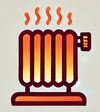When it comes to portable heaters, noise levels can vary significantly. Most portable heaters operate between 40 to 60 decibels, which is comparable to a quiet room or normal conversation. But, some models can be louder, reaching up to 70 decibels, similar to a vacuum cleaner.
If you’re sensitive to noise or plan to use your heater in a bedroom or office, it’s essential to choose a quieter model. Understanding these noise levels helps you find the perfect balance between warmth and comfort, ensuring your space stays cozy without the disruptive hum.
Understanding Portable Heater Noise Levels
Portable heater noise levels matter when choosing the right model for your space. High noise levels can disrupt quiet environments like offices or bedrooms. Understanding how noise levels affect comfort helps you make informed decisions.
Importance of Noise Levels in Portable Heaters
Noise levels in portable heaters range from 40 to 70 decibels. Lower levels, around 40 dB, create a peaceful atmosphere. This level is similar to a quiet library. A device operating at 60 dB resembles normal conversation. Noisy models, like those at 70 dB, sound like a vacuum cleaner. You can choose a heater that fits your noise tolerance. If you’re sensitive to sound, select a quieter model.
Common Noise Issues with Portable Heaters
Portable heaters face common noise issues. Some emit a loud whirring sound, distracting users. Others may produce clicking or popping noises during operation. These sounds often come from fan movement or heating elements. Such noise can disrupt sleep or work. Opt for heaters known for quieter operations. Models like the Vornado VH200 operate at approximately 45 dB, which is relatively quiet. The Lasko Portable Heater creates a gentle white noise, adding minimal disruption. Recognizing these issues can help you find a more suitable heater.
Types of Portable Heaters and Their Noise Levels
Portable heaters vary in noise levels. Choosing the right one can enhance your comfort. Here’s a breakdown of different types of heaters and their sound profiles.
Electric Heaters
Electric heaters are popular for home use. They come in various styles, including:
- Ceramic Heaters: Some models, like the Vornado VH200, operate quietly. The noise level is around 45 decibels at 3 feet, similar to a quiet library. Other options, like the Amazon Basics Small Space Heater, produce about 51.4 decibels. This sound is noticeable but not disruptive. The BUSYPIGGY Portable Electric Space Heater offers mixed reviews. Some users find it quiet, while others report clicking noises.
- Oscillating Heaters: These heaters can be louder due to their moving parts. The oscillation feature distributes heat but may cause additional noise. Be mindful of these models if you’re sensitive to sound.
Gas Heaters
Gas heaters are another option. They usually operate at higher noise levels, often between 50 to 70 decibels.
- Radiant Gas Heaters: These heaters typically run quietly, around 50 decibels. They offer warmth without much noise, making them suitable for living spaces.
- Propane Heaters: These can be louder, usually averaging around 65 decibels. They generate heat quickly but can disrupt quiet environments.
Oil-Filled Radiators
Oil-filled radiators are known for quiet operation. Their design allows for gentle heating without loud fans or mechanical parts.
- Noise Levels: These radiators operate around 35 to 50 decibels. They provide a soft, calming warmth, ideal for bedrooms or offices.
- Efficiency: They take time to heat up but maintain warmth longer. This slower heat-up time contributes to their quieter operation.
Selecting the right portable heater depends on your noise tolerance and heating needs. Evaluate the options based on how sound impacts your space and lifestyle.
Factors Affecting Noise Levels in Portable Heaters
Several factors influence noise levels in portable heaters. Understanding them helps you choose a model that suits your needs without disturbing your environment.
Design and Construction
Heater design and construction play significant roles in noise levels.
- Type of Heater: Radiator-type space heaters lack fans and generally produce the least noise, emitting sound levels between 25-40 dBA. This noise matches that of quiet background sounds in a home.
- Materials and Build: Metal casings often create more noise than plastic ones. Metal heaters may rattle or vibrate, while plastic designs tend to be quieter.
Fan Speed and Motor Functionality
Fan speed and motor functionality determine the noise output of portable heaters.
- Fan-Based Heaters: Space heaters with fans generate more noise than those without. A higher fan speed usually leads to louder operation. The whirring sound can be distracting, particularly in quieter spaces.
- Motor Quality: The quality of the motor can also affect noise levels. Well-built motors operate quietly, while lower-quality motors might produce clicking or humming sounds.
Heater Size and Capacity
The size and capacity of a heater affect its noise production.
- Small Heaters: Compact heaters typically operate at lower noise levels. They serve well in small rooms where added noise isn’t an issue.
- Large Heaters: Larger units often produce more noise due to increased fan speed and heating elements. These heaters are ideal for larger spaces, where noise may blend into the background.
Selecting the right portable heater involves knowing how these factors interact. This ensures you find a balance between heat output and noise comfort.
How to Choose a Quiet Portable Heater
Choosing a quiet portable heater involves understanding noise levels and selecting features that reduce sound. You’ll enhance your comfort by prioritizing tranquility in your environment.
Noise Level Ratings to Consider
When evaluating noise levels, consider heaters that operate below 60 decibels. This range mimics normal conversations, ensuring minimal disruption. Focus on specific ratings for various models:
- Vornado VH200: Operates at 45 dBA at 3 feet, 44 dBA at 6 feet.
- Infrared Heater: Operates at 34 dBA, similar to a library’s quietness.
- BUSYPIGGY Portable Electric Space Heater: Below 45 dB, but user opinions vary.
- Honeywell 360 Degree Surround Heater: Reaches 59.9 dB, which is quite loud.
- Vornado VHEAT Whole Room Vintage Heater: Operates at 59.6 dB, also on the louder side.
Features for Reducing Noise
Evaluate specific features that contribute to quieter operation. Look for these attributes:
- Fanless Design: Radiator-type heaters generate less sound, often between 25-40 dBA.
- Material Quality: Metal casings typically create more noise than plastic ones.
- Fan Speed: Lower speeds produce less noise. Opt for models with adjustable fan settings.
- Motor Quality: Higher-quality motors reduce operational noise.
Recommendations for Quiet Models
Select from models known for quiet performance. Here are some top recommendations:
- Vornado VH200: Quiet performance at 45 dB, ideal for bedrooms or offices.
- Lasko Portable Heater: Produces gentle white noise, minimizing disturbances.
- Oil-Filled Radiators: Range from 35-50 dB, excellent for tranquil spaces.
- Infrared Heaters: Operate quietly, perfect for smaller areas needing direct heat.
Selecting a model with these characteristics ensures comfort without disruptive noise in your living spaces.
Conclusion
Choosing the right portable heater involves more than just heating efficiency. Noise levels play a crucial role in your comfort and overall experience. By understanding the decibel ratings and selecting a model that aligns with your noise tolerance, you can enjoy warmth without disruptive sounds.
Keep in mind the type of heater and its design features. Opt for fanless models or those specifically designed for quiet operation if you value a peaceful environment. With the right choice, you can create a cozy space that meets your heating needs while maintaining tranquility. Prioritize your comfort and make an well-informed choice for a more enjoyable heating experience.








